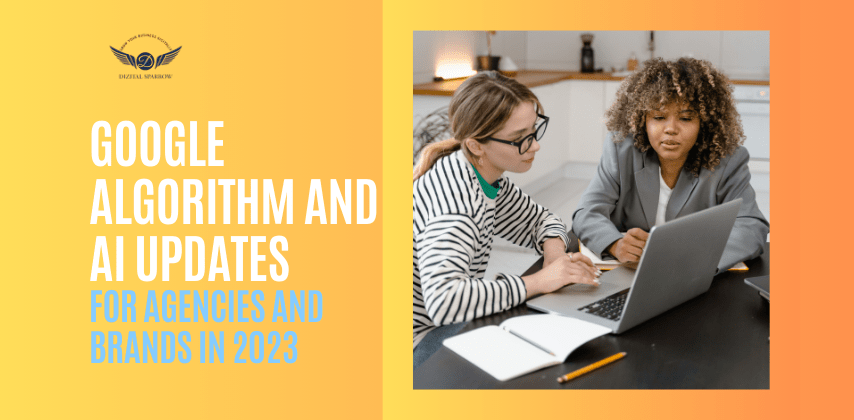Introduction
In the ever-evolving digital landscape, keeping up with Google’s algorithm and AI updates is crucial for agencies and brands to stay competitive and maintain a strong online presence. As we step into 2023, Google continues to refine its search algorithms and leverage artificial intelligence to enhance user experiences. In this article, we’ll explore some of the key updates and trends to watch out for this year.
BERT and Natural Language Processing (NLP)
BERT (Bidirectional Encoder Representations from Transformers) and Natural Language Processing (NLP) have revolutionized the way search engines understand and process human language. BERT, introduced by Google in 2019, is an advanced algorithm designed to comprehend the context and nuances of words within a sentence. Unlike previous algorithms that analyzed words in isolation, BERT considers the entire sentence’s context, enabling it to discern user intent more accurately.
NLP, on the other hand, refers to a broader branch of artificial intelligence that focuses on teaching robots to understand, interpret, and generate human language. BERT is a prime example of NLP’s practical application success. BERT and other NLP algorithms have far-reaching ramifications for search engine optimisation (SEO) and content development.
BERT has encouraged a shift in SEO towards more natural, conversational content. Websites must produce content that directly meets user queries, reflecting how people speak and ask inquiries, in order to rank higher in search results. Clarity and relevancy must be prioritised by brands and content developers to ensure their material corresponds with the intent driving user queries.
In essence, BERT and NLP have ushered in a new era of SEO and content marketing, where user-focused, context-rich content is paramount. Understanding and harnessing these technologies is essential for staying competitive in the digital landscape.
Core Web Vitals and Page Experience
Core Web Vitals and Page Experience are critical components of Google’s algorithm that directly impact a website’s search ranking and user satisfaction. Core Web Vitals are comprised of three essential metrics: Largest Contentful Paint (LCP), which measures page loading speed; First Input Delay (FID), which measures interactivity; and Cumulative Layout Shift (CLS), which evaluates visual stability while page loading.
Page Experience, on the other hand, includes a broader set of indicators such as mobile friendliness, secure browsing, HTTPS security, and invasive interstitial guidelines. It places a premium on providing customers with a smooth and comfortable surfing experience.
The importance of user-centric web design and speed optimisation is highlighted by Google’s emphasis on Core Web Vitals and Page Experience signals. Websites that prioritise rapid loading, smooth interactivity, and visual stability over other Page Experience factors are more likely to rank higher in search results and keep visitors. As a result, these metrics have become integral to effective SEO and web development strategies in today’s digital landscape.
Mobile-First Indexing
Mobile-First Indexing represents a pivotal shift in Google’s approach to evaluating and ranking websites for search results. Traditionally, Google primarily used desktop versions of websites for indexing and ranking. However, with the growing prevalence of mobile devices, Google now predominantly relies on a site’s mobile version to determine its search engine ranking.
This move highlights the need of mobile optimisation. Websites must be mobile-friendly, load quickly, and deliver an outstanding user experience. Text, photos, and videos must all be equally accessible and of excellent quality on desktop and mobile. Because Google prioritises delivering relevant and user-friendly results to mobile users, failing to optimise for mobile might result in poorer search engine rankings and exposure. In today’s mobile-centric digital market, adapting to Mobile-First Indexing is critical for maintaining a competitive online presence.
E-A-T (Expertise, Authoritativeness, Trustworthiness)
E-A-T, which stands for Expertise, Authoritativeness, and Trustworthiness, is a critical concept in the world of online content, particularly for Google’s search algorithm and content quality evaluation.
Expertise refers to the level of knowledge and skill demonstrated by the content creator or website in a particular field. High-quality content is often created by experts with deep knowledge and experience in their respective subjects.
Authoritativeness signifies the perceived authority or influence of a source. Authoritative content is typically from sources that are recognized and respected within their industry or niche.
Trustworthiness relates to the reliability and credibility of the content and its source. Trustworthy content is accurate, well-sourced, and transparent about its intentions.
Google is emphasising E-A-T when ranking web sites, especially for information involving health, finance, or other sensitive areas. E-A-T in your content and website can boost your online reputation and search engine ranking, making it a critical component of content production and SEO strategy.

AI-Powered Search Features
AI-Powered Search Features are a game changer in the world of online search and user experience. Artificial intelligence (AI) is being used to improve how people discover and interact with information on the internet.
Voice Search: AI-driven voice recognition technologies, such as Google Assistant and Amazon Alexa, enable users to perform searches by speaking naturally. This allows for more conversational interactions with search engines.
Image Recognition: AI algorithms are becoming increasingly adept at understanding and analyzing images. Users can search for products, information, and even similar images by uploading or taking pictures.
Predictive Text: AI predicts user queries as they type, offering suggestions in real-time. This feature not only speeds up the search process but also improves accuracy.
Personalized Recommendations: AI algorithms analyze user behavior and preferences to provide tailored search results and content recommendations, enhancing the overall user experience.
Semantic Search: AI-powered semantic search understands the context and intent behind user queries, delivering more relevant results by considering synonyms, natural language, and user history.
These AI-powered search capabilities not only make search engines more user-friendly, but they also allow businesses to communicate with their audiences more effectively. As AI advances, we may expect search experiences to become more intuitive and personalised.
Structured Data and Schema Markup
Structured Data and Schema Markup are invaluable tools in the field of search engine optimization (SEO) and web content presentation. They provide a standardized way to communicate essential information about web pages to search engines, making it easier for search engines to understand and index content accurately.
Structured Data labels and categorises items on a webpage using a specified vocabulary, such as Schema.org. This labelling can contain information on items, recipes, events, and other things. This structured data is used by search engines to generate rich search results such as featured snippets, knowledge panels, and event listings.
Websites that utilise Schema Markup can improve their exposure in search results, increase click-through rates, and give more useful and entertaining snippets to users. It’s an effective SEO approach that allows websites to stand out in a congested online world while also assisting search engines in providing more relevant and structured information to users.
Video SEO is a digital marketing technique that focuses on optimising video content for search engines, specifically Google, in order to increase its visibility and ranking in search results. With the explosive growth of video consumption on sites such as YouTube, optimising video content has become critical for businesses and content creators.
Effective Video SEO involves several key components:
Keyword Research: Identifying relevant keywords and phrases that users are likely to search for when looking for video content.
High-Quality Content: Creating engaging, informative, and well-produced videos that capture and retain the audience’s attention.
Optimized Metadata: Crafting attention-grabbing titles, descriptions, and tags that incorporate target keywords and accurately describe the video’s content.
Thumbnail Optimization: Designing compelling and relevant thumbnails that encourage users to click on the video.
Transcriptions and Closed Captions: Including transcriptions and closed captions to make the video more accessible and indexable by search engines.
Engagement Metrics: Encouraging likes, comments, shares, and subscriptions to signal to search engines that the video is valuable and engaging.
Video SEO not only increases video platform presence, but it may also improve a website’s overall SEO, increasing organic traffic and enhancing user experience. It’s a must-have technique for anyone who wants to harness the power of video in their online presence.
Local SEO and Google My Business
Local SEO and Google My Business (GMB) are critical for companies looking to connect with local clients. Local SEO entails optimising one’s online presence such that it appears highly in local search results, particularly on Google. GMB, a free Google product, is essential to this strategy.
Accurate Information: GMB ensures your business details, like name, address, phone number, and hours, are consistent and easily accessible online.
Local Reviews: Encouraging and managing customer reviews on GMB helps build trust and credibility.
Local Keywords: Targeting local keywords in website content and GMB listings helps businesses appear in relevant local searches.
Google Maps Integration: GMB connects with Google Maps, making it easier for users to find your physical location.
Local Posts: Posting updates, events, and offers on GMB keeps potential customers engaged and informed.
Local SEO and GMB optimisation allow businesses to efficiently target local audiences, increase foot traffic, and raise online presence in their regions.
you may also like-https://startupadvice.in/how-to-increase-the-organic-traffic-by-3x-through-guest-posting/
Conclusion
In 2023, Google’s algorithm and AI updates will continue to shape the digital landscape. Agencies and brands must stay proactive in adapting to these changes to maintain a strong online presence and deliver exceptional user experiences. By focusing on BERT, Core Web Vitals, mobile-first indexing, E-A-T, AI-powered features, structured data, video SEO, and local SEO, you can effectively traverse the dynamic search landscape and stay ahead of the competition. Stay tuned for future developments, and keep in mind that in the fast-paced world of SEO, a flexible and adaptable approach to digital marketing is essential.


Your point of view caught my eye and was very interesting. Thanks. I have a question for you.
Your article helped me a lot, is there any more related content? Thanks!
Your article helped me a lot, is there any more related content? Thanks!
Your article helped me a lot, is there any more related content? Thanks!
Thanks for sharing. I read many of your blog posts, cool, your blog is very good.
Thank you! Stay tuned for more blogs.